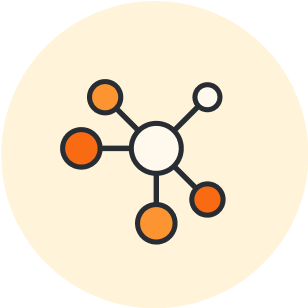
How to use the Agile RACI matrix for teams
Reading time: about 5 min
Agile RACI matrices get a bad rap. Some people believe they go against the spirit of Agile development and stifle flexibility, autonomy, and collective accountability. But in reality, adding a little structure to your team's roles can make it easier for everyone to perform at their best every sprint.
Keep reading to learn more about Agile RACI matrices, their benefits and drawbacks, and how to create one for yourself.
What is an Agile RACI matrix?
A RACI matrix is a type of responsibility assignment matrix or RAM. It increases transparency and ownership by outlining how people relate to specific tasks.
RACI stands for responsible, accountable, consulted, and informed. To create a RACI matrix, you take a particular piece of work and outline who fills each of these roles:
-
The responsible team member is the one who must do the work to complete the task.
-
The accountable team member is the person to whom the responsible member reports and who holds them accountable for doing the work on time and to the team's quality standards.
-
The consulted team members are those responsible for getting feedback, advice, or other input to do their work.
-
The informed team members are stakeholders who need updates on the work in progress but don't touch it directly.
How do RACI matrices work for Agile teams?
Agile teams often need to be cross-functional and have distributed authority. While this helps get the work done quickly, it can also get confusing. The more complex the team, the harder it is to know who is responsible for what.
RACI matrices clarify roles for each task. That way, each team member knows what to do, increasing transparency and ownership.
Benefits of using a RACI matrix in Agile
Agile teams depend on tight coordination to get their work done each sprint. RACI matrices help maintain efficiency and keep teams on track.
By clearly allocating tasks and responsibilities, RACI matrices give each team member a complete understanding of their role and responsibility. This eliminates role ambiguity, a problem where team members aren't sure what their job is or how to do it best. When employees know what they own and where and how they can contribute, they're free to do their best—improving both efficiency and morale.
RACI matrices also encourage collaboration by highlighting who needs to give input and who needs to update their work. This reminds the responsible party to reach out and meet those needs instead of trying to do things independently.
In the end, RACI matrices make work more transparent for everyone on the team. This is especially important for large, complex teams and for teams who are geographically dispersed. With lots of team members involved and teams who can't meet face to face, a RACI matrix helps to coordinate everything in a way that everyone can access.
Drawbacks and pitfalls of using a RACI matrix in Agile
While RACI matrices offer many benefits, the main drawback is that they are time consuming to create.
If you lead a team with members of similar work backgrounds who have worked together for a long time, you likely don’t need a RACI matrix. In this case, they probably already have an informal arrangement of who is responsible for what, especially if they work in the same location and do repeated tasks.
On the other hand, if you do implement a RACI matrix, you need to avoid some common pitfalls.
Making too many people responsible
If you assign multiple team members to be responsible for a task, then suddenly it feels like no one is. Don't spread task ownership too thin, or it gets confusing for everyone involved about who needs to do the job. Instead, keep the number of responsible parties to a minimum.
Having too few accountable parties
If you have to run all your decisions through one person, this can bottleneck the process, slowing productivity. Be judicious in who you mark as the accountable party and ensure they have the bandwidth to be responsive to the responsible parties.
Not involving stakeholders enough
When RACI matrices work correctly, they help keep everyone in the loop. However, occasionally, responsible parties see the consulted and informed categories as unnecessary since they are identified as not actually doing the work itself.
Stakeholders can feel excluded throughout the project if you don’t reach out to them consistently. Not only will they not advocate for your work, but they may undermine the project if they feel it won't meet their needs.
Be proactive in communication so you can get stakeholder buy-in and build something that everyone's excited about. These stakeholders may not be responsible for completing the task or accountable for the final product, but you still can't cut them out.
Best practices for creating a RACI matrix
If you create your own RACI matrix, keep these tips in mind.
Don't overburden team members
Creating your RACI matrix is a great opportunity to assess everyone's bandwidth. When you're assigning work to responsible parties, make sure to spread out tasks evenly.
Similarly, look at the stakeholders in the consulted category and make sure they need to be there. Can you take some work off their plate by switching them to the informed category?
Keep it simple
While RACI matrices have four categories, you may not need to fill all of them out for more simple tasks. If a task truly does not need anyone to consult on it, then don't put someone's name in for the sake of filling it in.
Inform the right people
Think carefully about who is in your informed category. Do they need to be there? If not, take them off the list. Is there anyone who does need to be kept up to date that isn't on the list? If so, add them.
Stay flexible
While a RACI matrix helps you plan things out, plans change. Feel free to edit the matrix when needed so that it stays a helpful tool instead of a hindrance.

Ready to create your own RACI matrix?
Check it outAbout Lucidchart
Lucidchart, a cloud-based intelligent diagramming application, is a core component of Lucid Software's Visual Collaboration Suite. This intuitive, cloud-based solution empowers teams to collaborate in real-time to build flowcharts, mockups, UML diagrams, customer journey maps, and more. Lucidchart propels teams forward to build the future faster. Lucid is proud to serve top businesses around the world, including customers such as Google, GE, and NBC Universal, and 99% of the Fortune 500. Lucid partners with industry leaders, including Google, Atlassian, and Microsoft. Since its founding, Lucid has received numerous awards for its products, business, and workplace culture. For more information, visit lucidchart.com.
Related articles
How to efficiently pull in project stakeholders across teams
In this blog post, you’ll learn how to identify project stakeholders, why managing stakeholders is important, and how to engage them in your project.
How the RACI matrix will streamline your project lifecycle
The RACI matrix helps project managers streamline their processes by ensuring each team member and stakeholder understands their specific roles. Learn why the RACI matrix is important and how you can take advantage of it in your next project.
How to manage common stakeholder issues and challenges
In this blog post, you will learn how to reduce project complications, and how to manage stakeholders.
How to nail your Agile communication plan
We’ll cover what makes Agile communication plans different and what best practices you can follow for creating an Agile communication plan that works for your team.
